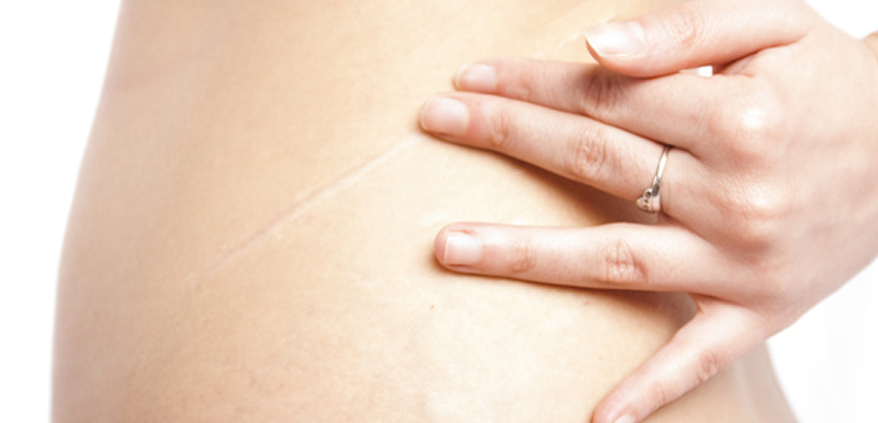Every scar is a mini miracle of regeneration. Just as a starfish builds a new arm, your skin automatically start rebuilding when you are cut, whether by injury or surgery. Your body starts by creating its own bandaid with the formation of a scab. Under that scab, skin and blood vessels begin to grow, and flexible collagen fibers reinforce the strength of the new tissue. The process starts immediately but it can take a year and a half before your scar is at its best.
Unfortunately, most before and after pictures are taken between 6 weeks and 6 months after surgery, while scars are still red and raised. Pictures of scars at 18 months are a much better indicator of how a scar will look. Just look at how the tummy tuck scar fades over an 18-month time frame:


Scars and surgery go hand-in-hand. There’s no way around it. But plastic surgeons have figured out ways to perform surgery to minimize the appearance of scars and even hide them. They also have steps you can take at home to get the best possible results.
After plastic surgery, Dr. Slack says, “You should expect swelling for the first few weeks and a thin scab which shortly dries up and falls off. At first, the scar will be pink or red and a little raised. At six months it will begin to regress.”
The appearance of a scar is greatly affected by the type of wound or incision, how well it heals, and also the forces placed upon it while it is forming. Scars that don’t heal well are generally categorized into four types:
Surface irregularities— these include acne scarring or minor discoloration and can also occur with surgical scars.
Hypertrophic scars–these are swollen, red, or raised scars that may broaden over time and remain lighter or darker than surrounding skin.
Keloids— these are bigger than hypertrophic scars and tend to be painful and itchy.
Contractures— these are the largest kind of scar, usually from a severe injury or a burn. They can limit movement of the affected area.
What plastic surgeons do to minimize your scar
Plastic surgeons, especially those that specialize in facial surgery (like Dr. Slack), have developed clever ways to reduce the appearance of scars, hiding them in the natural folds and hairlines of the body whenever possible.
Like all surgeons, they take great care to maintain sterile conditions during surgery to prevent infection. Infections not only impact the patient’s health, they can also result in an ugly scar. In some cases, a surgeon will also administer steroids to decrease inflammation.
Plastic surgeons use special wound closing methods too. One of the best techniques, according to a 2016 study, is called wound edge eversion–here the surgeon makes sure that the edges of the skin are slightly raised when sutured together. This leads to a flatter scar because wounds have a natural tendency to pull inward as they heal.
Another important factor in optimal scar formation is a highly secure incision site. To help with this, surgeons will often use multiple layers of stitches and even strips of tape to reinforce the incision.
What you can do to minimize your scar
The most important thing you can do after surgery is to follow your surgeon’s instructions. This includes initial wound and bandage care to prevent infection, as well as resting. Undue stress on your incision site can cause the formation of a larger or misshapen scar.
It is also likely that your surgeon will suggest the use of a corticosteroid or silicone based product once the wound heals. Multiple studies show these products are effective for reducing the appearance of scars, including two papers published this year (2016) in the journals Plastic and Reconstructive Surgery and Current Pharmaceutical Design. While corticosteroids are often just used initially, silicone gels or strips can be beneficial for up to six months.
These are all things you can do after surgery, but your first steps toward minimizing your scar actually start before surgery, when consulting with your plastic surgeon. Make sure to disclose all health issues including any skin conditions and history of poor scarring. You will also need to be in the habit of taking good care of yourself. And before surgery, you must quit smoking to improve healing and minimize scarring.
If you are considering a plastic surgery procedure and have questions about scarring, come in for a consultation with Dr. Slack.





